Cervical Cancer Awareness Month is observed every January to raise awareness and educate people about the importance of early detection of the disease and cervical cancer prevention. This cancer affects the cervix, which is the lower part of the uterus that is connected to the vagina. It is one of the most common types of cancer affecting women and can be fatal if not detected and treated early.
Cervical Cancer Awareness Month 2023 was first observed in the United States in the 1970s to promote the importance of regular Pap tests, which are used for cervical cancer screening. So widespread is the health condition across the world that an entire month is observed as Cervical Cancer Awareness Month. Each year, Cervical Cancer Awareness Month has a different theme. The theme for 2023 is “ending cervical cancer within few generations“.
2 Types Of Cervical Cancer & Its 5 Stages
As mentioned earlier, cervical cancer affects the cervix, which is the lower portion of the uterus that connects to the vagina.
There are two main types of cervical cancer, which are as below:
- Squamous cell carcinoma: This cancer begins in the thin, flat cells that line the cervix
- Adenocarcinoma: This cervical cancer has its origin in the glandular cells that produce mucus.
5 Stages Of Cervical Cancer
Cervical cancer stages are typically divided as stage 0, stage I, stage II, stage III, and stage IV.
- Stage 0, also known as carcinoma in situ, is the earliest stage of cervical cancer. This implies that the cancer cells are only found in the top layer of cells of the cervix.
- Stage I means that cancer has spread to the deeper layers of the cervix or to the tissue around the cervix.
- Stage II indicates that cancer has spread to the upper part of the vagina or to the lymph nodes near the cervix.
- Stage III means that cancer has spread to the lower part of the vagina or to the pelvic wall.
- Stage IV implies that cancer has spread to other parts of the body, such as the lungs or liver.
The cervical cancer survival rate depends on the stage of cancer at the time of diagnosis. If the cancer is detected in the early stages, the survival rate is high, with over 90% of people surviving for five years or more. If the cancer is not detected until the later stages, the survival rate is much lower. Detection in stage 1 or 0 of the cervical cancer stages is crucial for improving the chances of survival.
5 Possible Signs of Cervical Cancer
Cervical cancer symptoms include:
1. Abnormal Vaginal Bleeding
This includes bleeding between periods, after sex, or after menopause.
2. Vaginal Discharge
One of the common cervical cancer symptoms is a change in the amount, colour, or smell of vaginal discharge can be a sign of cervical cancer.
3. Pain During Sex
Pain during intercourse can be a symptom of cervical cancer.
4. Pelvic Pain
Persistent pelvic pain can be a sign of cervical cancer.
5. Urinary Problems
Difficulty urinating or a frequent need to urinate can be a symptom of cervical cancer.
It is important to note that cervical cancer symptoms may be caused by other conditions also. So, it is important to see a doctor if you experience any of the above-mentioned symptoms. Eventually, cervical cancer causes abnormal cells that may develop into cancer.
5 Possible Causes Of Cervical Cancer
Cervical cancer is caused by the human papillomavirus (HPV), which is a sexually transmitted infection. HPV is the most common sexually transmitted infection. While most people will not develop cervical cancer as a result of HPV, certain types of HPV increase the risk of developing cervical cancer. To be specific, HPV can get transmitted in the following instances:
1. Multiple Sexual Partners
Having multiple sexual partners increases the risk of HPV infection and, in turn, the risk of cervical cancer.
2. Early Sexual Activity
Starting sexual activity at a young age increases the risk of HPV infection and cervical cancer.
3. Smoking
Smoking increases the risk of cervical cancer.
4. Weak Immune System
People with a weak immune system, such as those with HIV/AIDS or those taking immunosuppressant medications, are at an increased risk of developing cervical cancer.
5. Family History
A family history of cervical cancer may increase the risk of developing the disease.
How Is Cervical Cancer Diagnosed?
A cervical cancer diagnosis is usually with a Pap test, also known as a Pap smear, which is a cervical screening test that looks for abnormal cells on the cervix. During a cervical cancer test, a healthcare provider will collect a sample of cells from the cervix using a small brush or spatula. The sample is then sent to a laboratory for testing.
If abnormal cells are found on the cervix, further testing may be needed to confirm the diagnosis. These tests may include a colposcopy, which is a procedure that uses a special instrument to examine the cervix, and a biopsy, which is a procedure that removes a small sample of tissue for testing.
In some cases, other tests may be needed to determine the stage of cancer and to help guide cervical cancer treatment decisions. These tests may include imaging tests, such as a CT scan or MRI, and blood tests.
It is important to see a healthcare provider regularly and to have regular Pap tests to help detect cervical cancer early. Early detection and treatment of cervical cancer can significantly improve the chances of survival.
3 Treatment Options For Cervical Cancer
There are several treatment options for cervical cancer, including:
1. Surgery
Surgery is a common treatment option for cervical cancer. The type of surgery will depend on the stage of cancer and the overall health of the patient. Options may include – Cryosurgery, Laser Surgery, Conisation and Hysterectomy.
2. Radiation Therapy
This treatment uses high-energy beams, such as X-rays, to kill cancer cells. It may be used alone or in combination with chemotherapy.
3. Chemotherapy
This treatment uses drugs to kill cancer cells. It may be used alone or in combination with radiation therapy.
5 Preventive Practises For Cervical Cancer
1. Cervical Cancer Vaccine
There are multiple cervical cancer vaccines available. The HPV vaccine is recommended for both boys and girls ages 11 to 12 and can also be given to people up to age 26. The cervical cancer vaccine is highly effective at preventing HPV infection and, in turn, cervical cancer.
2. Practice Safe Sex
Using condoms and practising monogamy can help reduce the risk.
3. Have Regular Pap Tests
Pap tests can help detect cervical cancer early when it is most treatable. It is recommended that women aged 21 to 65 have a Pap test every three years.
4. Quit Smoking
Smoking increases the risk of cervical cancer. Quitting smoking can help reduce the risk.
5. Maintain A Healthy Weight
Being overweight or obese may increase the risk of cervical cancer. Maintaining a healthy weight through diet and exercise can help reduce the risk.
Cervical Cancer Awareness is an important time to educate people about the importance of early detection and cervical cancer prevention of cervical cancer. By getting vaccinated against HPV, practising safe sex, and having regular cervical cancer screening, it is possible to significantly reduce the risk of developing cervical cancer. So, follow the above preventive tips and reduce the risk of cervical cancer.
Open up like never before and participate in conversations about beauty, entrepreneurship, mental health, menstrual & sexual health, and more. Desi women, join our community NOW!



